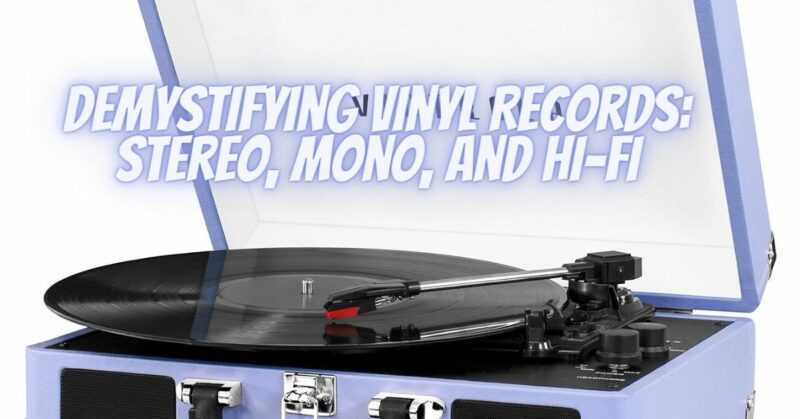Vinyl records have a rich history and a unique sound that continues to captivate audiophiles and music enthusiasts. One intriguing aspect of vinyl records is the diversity of formats, including stereo, mono, and hi-fi. In this article, we will explore the differences between stereo, mono, and hi-fi vinyl records, as well as how to identify them.
- Stereo Vinyl Records
Characteristics:
- Two Channels: Stereo vinyl records have two separate audio channels: left and right. This enables a spatial, multi-dimensional sound experience.
- Wider Soundstage: Stereo records offer a wider soundstage, allowing for better instrument separation and spatial imaging.
- Groove Variations: Stereo records have grooves that vary in depth and direction to accommodate the two audio channels.
Identification:
- Look for the terms “STEREO” or “STEREOPHONIC” on the record’s label or cover. These labels indicate that the record is in stereo.
- Check the matrix or run-out groove area for codes or markings that may indicate stereo format.
- Inspect the grooves: Stereo records typically have grooves that move both laterally (side to side) and vertically (up and down) to accommodate the two audio channels.
- Mono Vinyl Records
Characteristics:
- Single Channel: Mono vinyl records have a single audio channel, combining both the left and right channels into one.
- Narrow Soundstage: Mono records offer a narrower soundstage compared to stereo, with less spatial separation.
- Simpler Grooves: Grooves on mono records are simpler, with uniform depth and direction, as they carry a single audio signal.
Identification:
- Look for the term “MONO” or “MONOPHONIC” on the record’s label or cover. These labels indicate that the record is in mono.
- Check the matrix or run-out groove area for codes or markings that may indicate mono format.
- Inspect the grooves: Mono records typically have grooves that move only laterally (side to side) to carry the single audio channel.
- Hi-Fi Vinyl Records
Characteristics:
- High Fidelity: Hi-fi (short for “high fidelity”) refers to records that offer a high level of audio fidelity, striving to reproduce sound as accurately as possible.
- Quality Pressing: Hi-fi records are often pressed using high-quality materials and manufacturing processes to minimize surface noise and distortion.
- Clean Sound: Hi-fi records aim to provide a clean, detailed sound with minimal coloration or distortion.
Identification:
- The term “HI-FI” or “HIGH FIDELITY” may be found on the record’s label or cover.
- Look for other indicators of quality, such as the presence of premium audiophile labels like Mobile Fidelity Sound Lab (MFSL) or Analogue Productions.
It’s important to note that the terms “stereo,” “mono,” and “hi-fi” are not mutually exclusive. A record can be both stereo and hi-fi, or mono and hi-fi, depending on the recording and pressing quality. The key is to look for these specific labels and characteristics to identify the format accurately.
In conclusion, understanding the differences between stereo, mono, and hi-fi vinyl records can enhance your appreciation of vinyl as a format for music playback. Identifying these formats allows you to curate a vinyl collection that aligns with your listening preferences and audiophile interests. Whether you prefer the spatial richness of stereo, the simplicity of mono, or the high-fidelity experience of hi-fi, vinyl records offer a diverse world of sonic possibilities.


